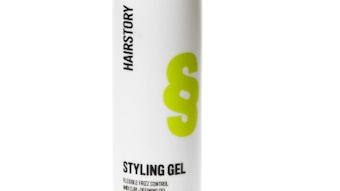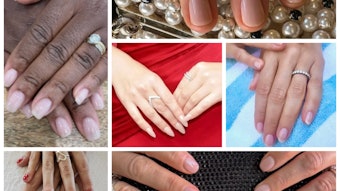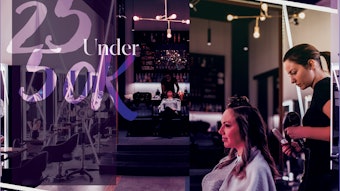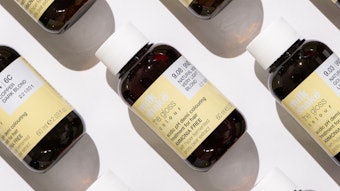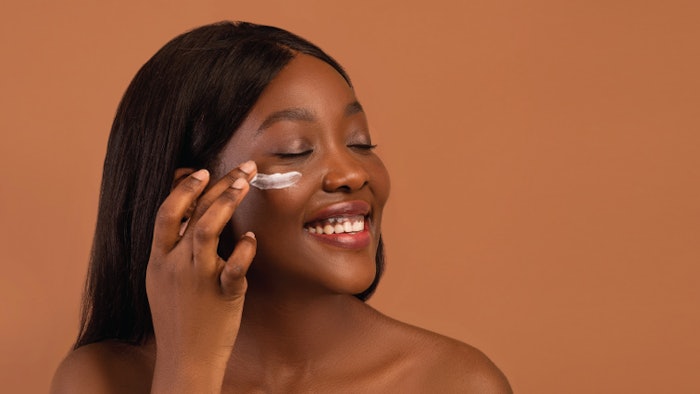
As a skin care educator who has trained hundreds, if not thousands, of skin care professionals over the course of my career, one point I always stress is how to properly prescribe products, not only for a client’s skin type and condition, but for each particular area of the face. This includes the eyes!
It’s so important that we educate our guests on the importance of a proper and consistent eye care routine. Eyes are really the first place to show any visible aging signs, due to the continuous movement with expression, and the structural differences, which most guests are not even aware exist. There are very few sebaceous glands around the eyes, so the lubrication, nourishment and natural protection for the skin barrier is not there. Also, adipose tissue is minimal, so the support for the skin is limited, which makes the skin thinner than the rest of the face.
Key Ingredients
Like with facial product ingredients, the ingredients found in eye care products, especially active ingredients including retinol (vitamin A), ascorbic acid (vitamin C) should be introduced into home care gradually. Formulas that contain not only key actives, but also other ingredients that help with barrier restoration like ceramides, linoleic, linolenic acid and sodium hyaluronate will help ensure the skin around this area is kept nourished and well hydrated.
To ensure no harm comes to this very delicate area, the ingredients used around the eye area are just as important as the ingredients to avoid. Guests should avoid using hydroxy acids such as lactic, mandelic and salicylic acids, as they could cause irritation and redness.
Figuring Out Formulations
As facial products can vary with differing bases, so can eye products. Some may be in an anhydrous (water-free) base and others a water base. At the brand I work with, vitamin C in an anhydrous base for stability of the ascorbic acid, so the base of the formulation will depend on the active ingredients within the product. Oils are generally not ideal as a base for eye creams, as they can leave an oily film across the eyes and affect vision. Additionally, eye masks can be made from varying ingredients such as hydrogel or biocellulose.
Related: Protocols in Practice: Eyes
Application Tips
As a skin care professional who has owned her own skin center and now oversees education for a global skin care brand, I’m always educating the proper application of skin care products, including eye products. My recommendation is to always use the size of a grain of rice for each eye. This is applied around the eye orbital rim (the eye socket) and spread into the skin, avoiding the eye lid and under the eyes close to the lashes.
To apply, begin at the arch of brow and work your way across your brow bone, spreading the eye cream until the product is completely absorbed. Gentle, circular motions that are moving in an outward motion across the brow and under the eyes towards the nasal ridge. No tapping movements, but spreading the product well into the skin around the eye. There is enough product so there will not be any stretching of the skin. Always be sure to avoid getting product too close to the eye area to prevent any irritation, and avoid applying to or near the eyelids and close to the lashes under the eyes.
When performing a treatment backbar, walk your guests through how to apply skin care products at home, especially for the eye area, so they go home with a proper understanding of how to perform their skin care routine.
It’s also critical to ensure clients do not apply too much product, which can have adverse effects. When too much is applied, this can cause the skin around the eyes to appear puffy, which would lead to stretching and sagging of the skin. When it comes to eye products, it’s a good reminder that a little goes a long way.
Benefits
Eyes really are the first part of a person’s face that we notice and engage with right away. Because the skin is so delicate and sensitive, they can also share a lot about how a person is feeling and how they are taking care of their skin. Maintaining a consistent skin care routine around the eye area will help ensure eyes look refreshed and rejuvenated. Additionally, the skin barrier function will improve, and sophisticated, medical-grade formulas will help smooth, plump, firm and refine the skin around the eyes.
My personal favorite is incorporating an eye care product that contains vitamin C for the day and a gentle retinol for nighttime. Of course, as with any daytime regimen, it’s crucial that clients finish their skin care routine with a suitable sunscreen with an SPF 30 or higher.
Introducing Eye Care
For guests who have mastered a simple three step skin care routine of cleanse, moisturize and protect, this might be the perfect opportunity to help step up their skin care routine, and introduce a proper eye care products as well. Whenever a guest is looking for an eye cream, always check what the guest may be cleansing their eyes with. So many cleansers, particularly foam or gel cleansers, have not been formulated for use around the eyes, which could result in dryness and premature skin aging. Recommending a suitable eye cleanser and eye cream that is hydrating may be the solution to help combat dryness and fine lines, especially around the eye area.
Eye of the Beholder
Of course, using high quality, professional skin care products is only part of the equation when it comes to protecting the delicate skin around the eye area. Taking a holistic approach to caring for the eyes, and the entire skin and body for that matter, is always the best approach. When educating your clients on proper at home skin care regimens, reemphasize the importance of taking these proactive, healthy steps to ensure results are not only achieved, but provide long-term benefits.
- Consider using at home cryotherapy tools such as ice globes, which are placed in the freezer, to massage the area around the eyes gently to increase circulation and decrease puffiness. When used appropriately, this can be very soothing around the eye area while providing noticeable benefits.
- Be sure to take off your eye makeup before going to bed! Even if you are so tired and have run out of energy by the end of the day, it’s so important to properly cleanse the face. If a guest tends to wear heavy eye makeup, be sure to prescribe a proper eye makeup remove that is mild and gentle enough to use around the eye area.
- Wear sunglasses and use SPF during the day! Most sunscreens have not been specifically formulated for the delicate eye area, so sunglasses are essential!
- Lastly, wear a wide-brim hat. This will help eyes to avoid direct sunlight. Ideally, the hat brim should be at least three inches broad.
Finally, why not suggest an upgrade for your guest’s next service and add in an eye enhancement. Incorporate some lymphatic massage movements to help reduce tension around the eyes and help reduce puffiness. It’s a great way to introduce your guests to home care eye products!
Tracey Beeby is an acknowledged expert within the skin care industry. Having worked in the industry for more than 35 years, Beeby’s professional experience extends from owning and running her own salons, to training doctors, business owners and skin technicians for the past 17 years. As Global Technical Training Manager for Ultraceuticals her focus is on raising the brands profile globally, and her work in advanced facial treatment development and clinical trials means that she knows how to achieve the very best results.







